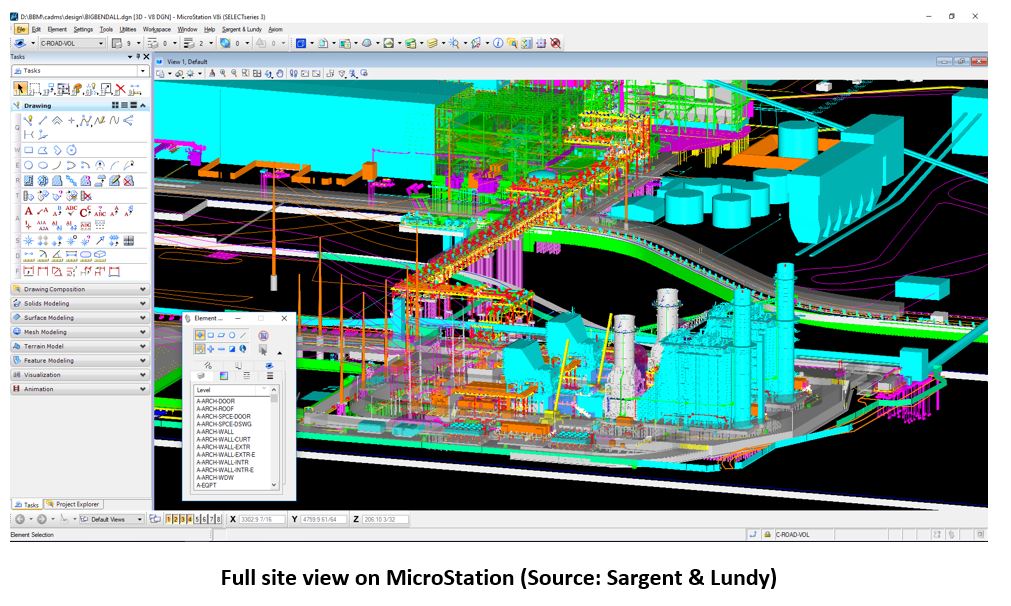

At the just concluded Bentley Systems’ YII 2019 conference in Singapore, Sargent & Lundy were among the finalists in the Power Generation category. Andy Chatha, President and CEO, ARC Advisory Group interviewed the team from Sargent & Lundy: James Stirk, Senior IT Manager; Krunal Patel, Structural Engineering Manager; Medhat Wagdy, Senior Project Specialist; and Edward Hanko, Design Manager.
In 2018, Tampa Electric Company (TEC), an Emera company, initiated a modernization project for its Big Bend Power Station located near Apollo Beach, Florida, to convert existing coal units to an efficient gas-fired combined-cycle facility. This project was initiated to continue providing safe, reliable, and cost-effective power to its customers while meeting growing demand. The improvements will eliminate coal consumption in generating electricity, use less water in the generation process, produce less wastewater, eliminate solid waste, and reduce air emissions. The estimated $850 million project requires coordinating existing on-site equipment and facilities with new infrastructure, complex piping systems, and all project participants. After careful evaluation, the company chose Sargent & Lundy, specialists in detailed engineering, design, and on-site construction management. The Sargent & Lundy team used Bentley software tools to develop a digital twin that improved design accuracy and minimized on-site rework, saving estimated millions in design and construction costs. Real-time design reviews with improved visualization saved additional project costs.
The team merged 3D laser scans of the existing structures, vendors provided model files, and Sargent & Lundy developed new design models using MicroStation and OpenBuildings Designer BIM (Building Information Modeling), developing a digital twin that improved design accuracy by approximately 20 percent. A digital twin also minimized on-site rework, saving an estimated $1 million to $2 million in construction costs. STAAD.Pro helped develop optimized design options to accommodate the complex, 400-foot pipe span, saving 350 tons of steel and approximately $2 million.
Sargent & Lundy uses many of the Bentley products and is standardized on Bentley software for plant design projects. They have been using MicroStation since the 1980s; and MicroStation 4 and BIM modeling from the 1990s, so the digital twin doesn’t seem like such a new concept to them. Andy learned that a digital twin of the existing infrastructure was created using laser scans of the physical assets and enhanced with the plant’s engineering data, allowing integration of the existing and new designs. The design stage took about 18 months to complete.
Currently, the company is in the process of completing the design and passing it over to construction where they are using the digital twin. This digital twin is updated continuously as the design matures to create a virtual copy of the facility at any point in the project. The digital twin is critical to allow visualization and access to the physical and engineering data throughout the design and construction of the facility.
Bentley’s interoperability capabilities allow collaboration with multiple equipment vendors for the plant. The vendor provided graphics are imported into the centralized BIM model. This seamless interoperability resulted in minimal disruption across the distributed project team, according to the Sargent & Lundy team.

The new design tools save time, live feedback is reliable, and it’s far easier to update the existing models. Digital twin tools are making it easier to simulate the plant as they provide dynamic views.
In the 1980s, Sargent & Lundy needed 50-60 designers to design a project similar to this one; now the number has reduced to around 15 designers. So costs are drastically cut for the client. Without these design tools there would be more errors in the field requiring more rework and time. The Sargent & Lundy team uses on-premise servers for design work but provide access to data and files, both in the office or remotely.
Currently, Sargent & Lundy has a streamlined process to receive vendor documents that are added to the system. Andy suggested that the Sargent & Lundy team should create a project portal for all project related documentation, where suppliers could upload their documents.
Sargent & Lundy is one of the oldest and most experienced full-service architect engineering firms in the world. Founded in 1891, the firm is a global leader in power and energy with expertise in grid modernization, renewable energy, energy storage, nuclear power, and fossil fuels.

